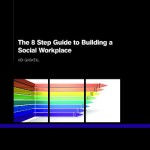The 8 Step Guide to a Social Workplace will give you:
- An overview of the primary changes social business is imparting upon organisational behaviour
- Explore the challenges and risks involved in becoming a social business
- Outline 8 levers of change that can be used to help create a social workplace
Why the report matters
Social business related projects have a dire success rate, with 80% said to fail to deliver the results expected of them. I believe a major part of this failure is the focus upon tools and technologies rather than culture.
This has resulted in organisations purchasing social technologies but failing to adjust the rest of their organisational traits to reflect their ambitions to become more collaborative and innovative.
This report will give you a template to change that. It will outline 8 key areas to focus on to help encourage the kind of collaborative workplaces needed for the knowledge economy, laying the foundations for you to become a social business.
What people say
“an interesting insight into how to make social business work, and comes very much as the enterprise 2.0 wave shifts its focus from to culture and behavior.” The Social Workplace
“Through various use cases, from thought leaders in the industry, Adi explains in a clear and concise manner how the game is played.., and won.” Rogier Noort, social business blogger for Enterprise 2.0 Paris
“This book is an excellent contribution to the argument. If he can persuade a single CEO to see why the social workplace could benefit the bottom line, then it will have justified the work of creating it.” Lawrence Clarke and Peter Furtado, Shillbrook Associates
Browse the executive summary and table of contents below, or purchase the report here.

This is a really excellent book, both in its content and the fluency and accessibility of the writing. I do not see anything of its nature as comparable in breadth, depth and insight into what might not be a new field, but is a yet as conquered field.
As a lecturer in business and a practitioner in organisational communication, I was surprised about how much I learnt through reading the book. There are many excellent books and articles on analysing all different aspects of the social media terrain, but few that manage to integrate this analysis into a coherent (and tractable) whole. Adi's book stands out for doing just that – through what it says on the tin: the 8 Steps.
The one challenge I would have, and it's not about the book, relates to the price of the publication and the volume in circulation. I do not see how the publication can see uptake and become a working textbook for communications teaching without this barrier to access being overcome. As an university educator, I have the good fortune to be able to access most UK university libraries through the ScoNul scheme. I am subscribed to a large number of London-based institutions, but only two of these had the book on their shelves. Without such a privilege there is no way that my students can be expected to use this book as a core text and, it being out of the reach of the individual user, it is a case of make-do with inferior publications.
For those who do have access and the time to work through 'the 8 steps', I believe it will be of immense value.
Jonathan
Thanks for the kind words Jonathan, I'm very glad you found it interesting and insightful.